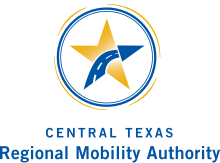Central Texas Regional Mobility Authority
The Central Texas Regional Mobility Authority (CTRMA) is an independent government agency created in 2003 to improve the transportation system in Travis and Williamson Counties in Texas. The Mobility Authority is headquartered at 3300 N. IH 35 in Austin.
 CTRMA logo | |
| Authority overview | |
|---|---|
| Formed | 2003 |
| Type | Authority |
| Jurisdiction | Travis and Williamson Counties |
| Headquarters | 3300 N. IH 35, Austin, Tx 78705 |
| Authority executive |
|
| Website | www |
The Mobility Authority is overseen by a seven-member Board of Directors.[1] The Governor appoints the Chairman, and the Travis and Williamson Counties Commissioners Courts each appoint three members to serve on the Board.
The Mobility Authority employs a professional staff of 29 led by Executive Director Mike Heiligenstein. The Mobility Authority uses private sector contractors with specialized expertise to provide staffing support for individual projects.
The Mobility Authority was created and operates under the Texas Transportation Code Chapter 370 and is authorized under state law to implement a wide range of transportation systems including roadways, airports, seaports and transit services. The Mobility Authority is authorized to issue revenue bonds to fund projects and relies on toll collections to repay its bonds. It can receive grants from other government agencies to help finance projects, but does not have its own taxing authority.[2]
Projects
183A Toll Road
The Mobility Authority's first project was 183A, an 11.6 mile (18.7 km) toll road in southwest Williamson County. Construction of the US $238 million toll road began in March 2005 and was opened to traffic in March 2007.[3] The road serves the fast-growing suburban communities of Cedar Park, Leander and Liberty Hill. 183A features a state-of-the art electronic toll collection system and became the second toll road in the United States to convert to cashless all-electronic tolling on December 1, 2008.[4]
290 Toll Road
The Mobility Authority's second project was the 290 toll road, constructed in phases starting in 2010. Phase 1 of the project involved construction of four direct connect flyover ramps at the interchange between US 183 and US 290. The flyovers opened to traffic in December 2012. Phase 2 involved constructing three tolled lanes and three non-tolled frontage road lanes in each direction on a 6.2 mile (10.0 km) stretch of US 290 from US 183 to Manor just east of FM 734/Parmer Lane. The US $426 million project opened to traffic in May 2014.[5] The project was designed from the outset to be among the first all-electronic cashless toll roads in the United States with no traditional cash toll booths.
183A Northern Extension
Also in 2010, the Mobility Authority began a project to extend the tolled lanes of 183A 5-miles (8.0 km) from FM 1431/Whitestone Boulevard to near San Gabriel Parkway in Leander. The US $105 million 183A Northern Extension project was opened to traffic in April 2012.[6]
MoPac Express Lanes
In October 2013, the Mobility Authority began construction off the US $204 million MoPac Improvement Project, an 11-mile (17.7 km) express lane project with Congestion pricing between Cesar Chavez Street in downtown Austin and FM 734/Parmer Lane in North Austin. The project involved expanding State Loop 1/MoPac Boulevard by adding one tolled lane in each direction along the median of the highway. The first section of northbound toll lane between RM 2222/Northland Boulevard and FM 734/Parmer Lane opened in October 2016. The remaining lanes, in both directions, were opened in phases in October 2017.[7]
Other Roadways
Other Mobility Authority roadways open to traffic include the 4-mile 71 Toll Road adjacent to Austin-Bergstrom International Airport[8] and the 3.5-mile 45 Southwest Toll Road in south Austin.[9] The Mobility Authority also opened a portion of the 183 South Toll Road in east Austin in August 2019.[10]
Financial
According to the 2012 Financial Audit, the Mobility Authority’s main sources of revenue are tolls ($23.6 million) and federal and state highway funds ($28.4 million). Total operating expenses total $17 million. The organization pays some $12 million annually to service a debt of $681 million.
In late 2012, the Capital Area Metropolitan Planning Organization decided to place $130 million in available state and federal funds with the Mobility Authority, which plans to use the money for the MoPac Project approved by the Federal Highway Administration. The Mobility Authority will place $230 million into a fund available to CAMPO for transportation projects over a set timeframe, effectively leveraging the available funds to develop future funding through the construction of a partially tolled roadway.
Governance
The Mobility Authority is an independent government agency with a seven-member Board of Directors. The Chairman of the Board is appointed by the Governor of Texas. The Travis County Commissioner's Court appoints three members and the Williamson County Commissioner's Court appoints three. The Board Members serve two year terms and can be reappointed. The Mobility Authority is run by Executive Director Mike Heiligenstein and a staff of approximately a dozen individuals.
There has been controversy in Texas over foreign and private ownership of roadways, but all of the Mobility Authority’s properties are owned and operated by the organization, which is a public, nonprofit entity. The Mobility Authority is governed by a Board of Directors composed of a chair selected by the governor, three appointed by the Travis County Commissioners Court and three selected by the Williamson County Commissioners Court. The Board members serve two-year terms and are not compensated for their service.
References
- Mobility Authority Board of Directors, from mobilityauthority.com, accessed April 16/2013.
- Texas Transportation Code Chapter 370
- Mobility Authority Open Roads - 183A
- Mobility Authority Press Release 12/7/08
- Mobility Authority Open Roads - 290 Toll
- Mobility Authority Press Release 04/06/12
- Mobility Authority Press Release 10/17/13
- Mobility Authority Open Road - 71 Toll Lane
- Mobility Authority Open Roads - 45SW
- Mobility Authority Open Roads - 183 South